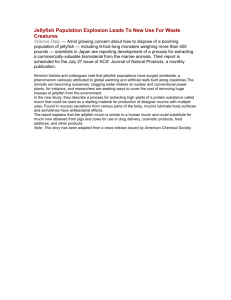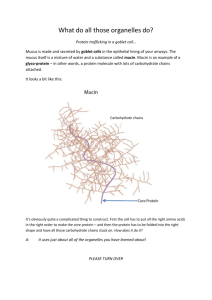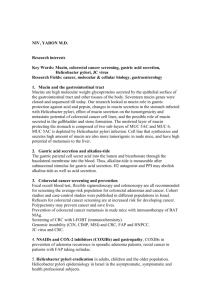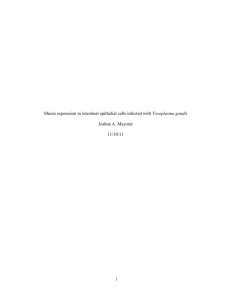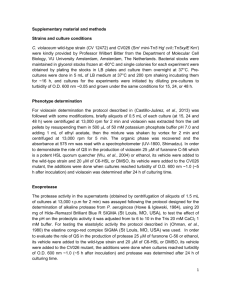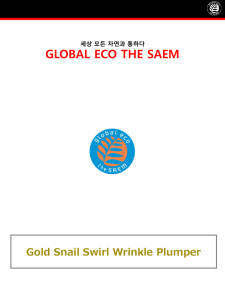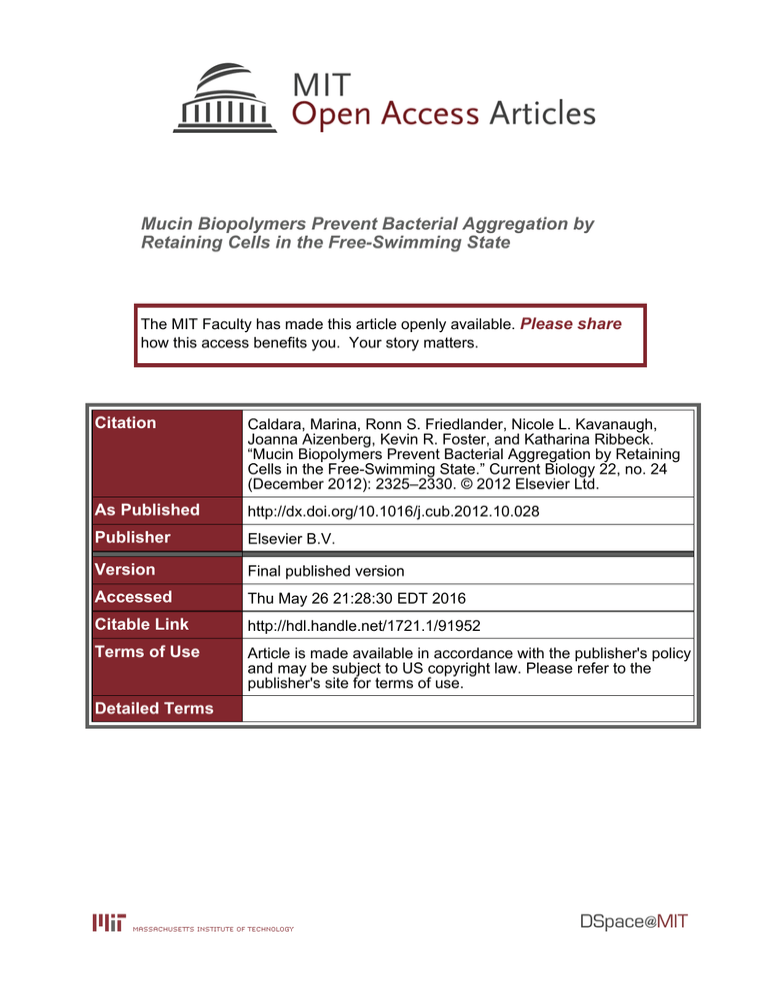
Mucin Biopolymers Prevent Bacterial Aggregation by
Retaining Cells in the Free-Swimming State
The MIT Faculty has made this article openly available. Please share
how this access benefits you. Your story matters.
Citation
Caldara, Marina, Ronn S. Friedlander, Nicole L. Kavanaugh,
Joanna Aizenberg, Kevin R. Foster, and Katharina Ribbeck.
“Mucin Biopolymers Prevent Bacterial Aggregation by Retaining
Cells in the Free-Swimming State.” Current Biology 22, no. 24
(December 2012): 2325–2330. © 2012 Elsevier Ltd.
As Published
http://dx.doi.org/10.1016/j.cub.2012.10.028
Publisher
Elsevier B.V.
Version
Final published version
Accessed
Thu May 26 21:28:30 EDT 2016
Citable Link
http://hdl.handle.net/1721.1/91952
Terms of Use
Article is made available in accordance with the publisher's policy
and may be subject to US copyright law. Please refer to the
publisher's site for terms of use.
Detailed Terms
Current Biology 22, 2325–2330, December 18, 2012 ª2012 Elsevier Ltd All rights reserved
http://dx.doi.org/10.1016/j.cub.2012.10.028
Report
Mucin Biopolymers Prevent
Bacterial Aggregation by Retaining
Cells in the Free-Swimming State
Marina Caldara,1,8 Ronn S. Friedlander,2,8
Nicole L. Kavanaugh,1,3 Joanna Aizenberg,4,5
Kevin R. Foster,6,7 and Katharina Ribbeck1,*
1Department of Biological Engineering, Massachusetts
Institute of Technology, 32 Vassar Street, Building 56-341,
Cambridge, MA 02139, USA
2Harvard-MIT Division of Health Sciences and Technology,
Cambridge, MA 02139, USA
3Microbiology Graduate Program, Massachusetts Institute
of Technology, Cambridge, MA 02139, USA
4Wyss Institute for Biologically Inspired Engineering
5Kavli Institute for Bionano Science and Technology
School of Engineering and Applied Sciences, Harvard
University, Cambridge, MA 02138, USA
6Department of Zoology, University of Oxford, South Parks
Road, Oxford OX1 3PS, UK
7Oxford Centre for Integrative Systems Biology, University
of Oxford, South Parks Road, Oxford OX1 3QU, UK
Summary
Many species of bacteria form surface-attached communities known as biofilms. Surrounded in secreted polymers,
these aggregates are difficult both to prevent and eradicate,
posing problems for medicine and industry [1, 2]. Humans
play host to hundreds of trillions of microbes that live adjacent to our epithelia, and we are typically able to prevent
harmful colonization. Mucus, the hydrogel overlying all wet
epithelia in the body, can prevent bacterial contact with the
underlying tissue. The digestive tract, for example, is lined
by a firmly adherent mucus layer that is typically devoid of
bacteria, followed by a second, loosely adherent layer that
contains numerous bacteria [3]. Here, we investigate the
role of mucus as a principle arena for host-microbe interactions. Using defined in vitro assays, we found that mucin
biopolymers, the main functional constituents of mucus,
promote the motility of planktonic bacteria and prevent their
adhesion to underlying surfaces. The deletion of motility
genes, however, allows Pseudomonas aeruginosa to overcome the dispersive effects of mucus and form suspended
antibiotic-resistant flocs, which mirror the clustered morphology of immotile natural isolates found in the cystic
fibrosis lung mucus [4, 5]. Mucus may offer new strategies
to target bacterial virulence, such as the design of antibiofilm coatings for implants.
Results and Discussion
Mucins Reduce Surface Adhesion and Biofilm Formation
of P. aeruginosa
To begin to dissect mucin-bacterial interactions, we developed an in vitro assay that uses defined concentrations of
native mucins. As a source of mucins, we purified native
8These authors contributed equally to this work
*Correspondence: ribbeck@mit.edu
porcine gastric mucus to obtain an extract composed
predominantly of MUC5AC, which is one of the major gel-forming components of the mucus in the lungs and stomach [6].
The use of natively purified mucins is decisive for the utility
of this assay, because commercially available mucins are processed and have lost the ability to form viscoelastic hydrogels,
as are generated by the native polymers [7, 8]. The second
critical feature for this assay is the presentation of mucins in
solution, as they exist in the secreted lung mucus, instead
of depositing them onto a surface. This detail is important
because the surface deposition of mucins is likely to adsorb
functional groups, thereby partially dehydrating and altering
the biochemical activity of the polymer.
First, we tested the effect of mucins on the ability of
bacteria to colonize an immersed surface. A glass coverslip
was suspended in culture medium that contained physiological concentrations of mucins [9]. Using the motile, opportunistic pathogen Pseudomonas aeruginosa, we quantified
firm attachment by placing exponential-phase cells in contact
with the coverslip and imaging, using phase-contrast microscopy. Cells that adhered to the surface and fully arrested
(based on overlaying pairs of images separated by 2 s) were
considered firmly attached and were counted at 20 min intervals (Figure 1A).
We found that mucins reduced bacterial surface adhesion
by 20-fold over a 70 min period (Figure 1B). To test whether
this inhibitory effect was specific to the mucins or a generic
result of the presence of polymers, we compared the effects
of mucins to the effects of solutions of polyethylene glycol
(PEG), a polymer often used as an antiadhesive coating [10],
and dextran, a branched, high-molecular-weight polysaccharide. In comparison to mucins, PEG and dextran demonstrated
only mild reductions in bacterial adhesion at these early time
points, indicating that mucins have singular effects that cannot
be attributed to nonspecific effects of polysaccharides or
soluble polymers alone. At 6 hr, a time at which biofilms have
begun to form, approximately 90% of P. aeruginosa cells remained planktonic in the presence of mucins, compared with
50%–60% in tryptone broth (TB) alone or TB plus PEG or
dextran (Figure 1C).
Mucin Gels Maintain or Augment Bacterial Swimming
Motility
It is tempting to speculate that bacteria failed to access the
underlying surface because they were trapped within the
mucin network. If this is true, we should expect to see
a measurable decrease of motility within the mucin hydrogel.
First, to test whether motion was hindered in the presence of
mucins, we tracked the movements of P. aeruginosa cells
that carried a deletion in the flagellar hook gene (flgE) and were
thus deficient in self-propulsion. These cells demonstrated
a significant decrease in diffusivity (p < 0.001) in mucin environments, from 2.4 6 0.2 3 1029 cm2/s to 1.0 6 0.1 3 1029 cm2/s
(n R 96 cells), reflecting a higher apparent viscosity of mucincontaining gels and suggesting that geometric hindrance was
present. However, the wild-type cells remained highly motile in
the presence of the mucins (see Movies S1, S2, S3, S4, and S5
available online). The distribution of velocities of swimming
Current Biology Vol 22 No 24
2326
Figure 1. Mucins Block P. aeruginosa Attachment to Surfaces
(A) Images of coverglass surfaces at the indicated time points, depicting cell adhesion. Cells
in PMM or PMM plus mucins were photographed
at 2 s intervals at each time point. Images from
these intervals were false colored in red and
green, respectively, and overlaid, allowing visualization of active cell motility or Brownian motion
versus firm adhesion. Scale bar represents
10 mm.
(B) Number of wild-type cells firmly adherent to
coverglass in PMM, or PMM supplemented with
PEG, dextran, or mucins, after the indicated incubation periods. Error bars indicate SEM of 8–11
different data points.
(C) PAO1 wild-type bacteria were grown in polypropylene tubes containing TB or TB plus 1%
(w/v) PEG, dextran, or mucin. After 6 hr, the
relative amount of planktonic versus surfaceattached cells was quantified using MTT staining.
Error bars represent the SD.
cells in mucins was similar to that in liquid medium, despite the
differences in apparent viscosity (Figures 2A and S1A available
online). This effect was apparent when we compared cells in
Pseudomonas minimal medium (PMM) as well as in tryptone
broth (TB) with or without mucins. To test whether this effect
is specific for Pseudomonas or whether it is a more general
phenomenon that affects other swimming bacteria, we tracked
a different motile bacterium, Escherichia coli. Despite a significant decrease in diffusivity (p < 0.001) of nonflagellated cells
(DfliC) in mucins, from 2.2 6 0.2 3 1029 cm2/s to 0.7 6 0.1 3
1029 cm2/s (n R 92 cells), the wild-type cells had significantly
increased swimming velocities in mucins compared with
medium only (Figures S1B and S1C).
Immotile P. aeruginosa Cells Can Form Suspended Flocs
in Mucin Gels
If mucins can prevent surface colonization by maintaining
cellular motility, we speculated that cells lacking motility may
be able to overcome this dispersion effect and succeed in
adhesion and biofilm formation in mucin environments. This
line of inquiry may have direct physiological relevance, as
isolates of P. aeruginosa from cystic fibrosis (CF) mucus are
often nonmotile [5]. As with the wild-type, mucins detectably
reduced surface adhesion of nonmotile cells (DflgE), which
are already poorly adherent (Figure S1D; compare to Figure 1B). To look beyond surface adhesion in the presence of
mucins, we observed the bacteria in the volume of the mucin
gel after 20 hr of incubation. The wild-type cells remained
largely as individual cells or small, suspended colonies
(Figures 2B and 2C) of up to 20 mm2 (this corresponds roughly
to clusters of 10–20 cells) distributed throughout the volume of
the mucin medium. Increasing mucin concentration did not
visibly increase cellular cluster size (Figure 2E). However,
when observing the DflgE mutant, we noticed a striking difference compared to the behavior of wild-type cells. The flagella
mutant formed large aggregated flocs of up to 250 mm2
(Figures 2B and 2C). These differences are not likely due to
variations in cellular populations in the mucin medium,
because PAO1 displayed similar growth rates in the presence
and absence of mucins (Figure S1E). A
similar behavior was found for two additional flagella mutants, DflgK, which lack
a hook filament junction protein, and DfliD, which lack an adhesive protein at the tip of the flagellar filament (Figures 2B, 2C,
and S1F), but not for DpilB, which lack pilus-mediated adhesion and twitching motility (Figures 2B and 2C). The ability of
cells to form suspended flocs was inversely correlated with
their ability to form surface biofilms in mucin-free environments (Figure 2D). For example, wild-type and DpilB cells
formed substantial surface biofilms but failed to form large
suspended flocs in the presence of mucins. Conversely, the
various flagellar mutants formed large flocs, but had reduced
surface biofilms in the absence of mucins. All mutants tested
displayed similar growth rates (Figure S1G). The flocs formed
by DflgE strains increased in maximum size with increasing
mucin concentration (Figure 2F).
We hypothesized that loss of flagellar motility (rather than
other properties of flagella, such as adhesion) was the dominant contributor to the observed aggregation. To test this,
we measured mucin-dependent flocculation by a PA14 strain
that carries a fully assembled flagellum but is paralyzed, due
to deletions in all four stators in the motor complex (DmotABD
motCD). This mutant formed substantially larger flocs (up to
60 mm2) than the wild-type (Figures S1H and S1I), but the structures were smaller than those formed by the DflgK strain.
Again, floc-forming ability in mucins tended to be negatively
correlated with surface biofilm formation in medium-only environments (Figure S1J). Both a loss of motility and loss of the
flagella itself, therefore, appear to contribute to mucus colonization. Complementing the flgE deletion in PAO1 DflgE
restored swimming motility and diminished the capacity of
the bacteria to form flocs in mucin, indicating that it is indeed
the lack of functional flagella that caused the formation of
flocs (Figure S2).
Our data suggest that mucins are highly effective at preventing swimming cells from surface attachment and forming
suspended aggregates. Previous work has indicated that fliD
is an adhesin for mucin [12], yet it does not appear to be
required for the aggregative phenotype (Figure 2C). How
then do the flagella mutants achieve aggregate formation? It
appears that their lack of motility enables cells to form clonal
Mucins Prevent Bacterial Aggregation
2327
Figure 2. Nonmotile Flagella Mutants, but Not Their Motile Counterparts, Form Flocs in Mucin Environments
(A) Box plots depicting swimming velocities of P. aeruginosa in various conditions. Cells were grown in the media indicated, but swimming experiments
were in 50% strength media. Velocities were obtained from particle-tracking analyses of 20 s swimming videos obtained at 20 frames per second. See
also Movies S1, S2, S3, S4, and S5.
(B) Floc formation of wild-type cells, flagella mutant (DflgE), pili mutant (DpilB), and double flagella and pili mutant (DflgEDpilB) in PMM with 1% mucins after
20 hr of incubation. Images are of cells in suspension only. Scale bar is 20 mm.
(C, E, and F) Box plots quantifying floc size of wild-type, flagella, pili, matrix, and motility mutants for the strains indicated in mm2 after 20 hr of growth in 1%
mucin (unless otherwise indicated). For details on the quantification method see Experimental Procedures. For all box plots, boxes extend from the 25th to
the 75th percentile, the central line is the median, and whiskers extend to the data point nearest to 1.5 times the interquartile range above and below the box.
Outliers are plotted as plus signs.
(D) Surface-attached biofilm formation was quantified by crystal violet (CV): liquid cultures of the strains indicated were inoculated in 96-well plates at an
OD600 of 0.01 and incubated for 7 hr at 37 C. The biofilms that formed were quantified by staining with 0.1% CV as described previously [11]. After staining,
each plate was rinsed, and the remaining CV was destained with 33% acetic acid for 15 min, and measured using a plate reader (OD595). Data are presented
as percent biofilm formation relative to wild-type. The error bars represent SD. See also Figure S1.
outgrowths of individual cells within the mucus. This was supported by culturing mixtures of fluorescent and nonfluorescent
immotile cells in mucin medium. Over the course of 20 hr, small
homogeneous patches of 10–20 cells emerged and further
expanded (Figure S2). Notably, floc formation did not occur
in PEG, dextran, or industrially purified mucins (Figure 3A). It
appears that this phenomenon depends on specific features
unique to native mucins.
P. aeruginosa Floc Formation Is Dependent on the
Production of Psl and Alginate
Flagella loss allows bacteria to effectively colonize mucus in
a manner reminiscent of surface-attached biofilms. Just how
similar are these two forms of bacterial aggregation? To
address this, we tested whether floc formation by nonmotile
cells required an extracellular matrix, a hallmark of biofilms.
Specifically, we looked at Psl, which plays a structural role in
the maturation of surface-attached biofilms [13], and alginate,
which appears to play only a minor role in biofilm formation
(Figure 3B; [14]) but is overexpressed in colonies adapted to
growth in CF lung mucus [15, 16]. Using previously characterized single algD and psl mutant strains [13, 17], we introduced
additional flgE mutations to study the importance of the
extracellular matrix on the immotile flocs. Complementation
of the double mutants with flgE was able to restore motility
(Figure S2). We found that both polymers, particularly alginate,
were important for floc formation (Figures 3C and 3D), because
in their absence, floc size was greatly reduced. This phenotype
may be relevant to CF pathology, where the formation of
P. aeruginosa flocs inside the lung mucus is associated with
the rise of antibiotic resistance [18]. These data suggest that
mucin-based flocs and surface-attached biofilms have the
same broad reliance on extracellular matrices, but the mechanistic details differ in important ways. Specifically, flocs rely on
alginate and flagella loss in a manner not seen in surfaceattached biofilms.
P. aeruginosa Flocs that Emerge in Mucin Gels Are
Antibiotic Resistant
Last, we asked whether floc formation can provide bacteria
with a selective advantage. Again by analogy with biofilms,
we hypothesized that the immotile cellular aggregates that
emerge in the presence of mucins also have a higher resistance toward antibiotics compared to motile wild-type cells.
We grew wild-type and the nonmotile DflgE cells in mucin
media for 20 hr and then subjected both strains to two clinically
Current Biology Vol 22 No 24
2328
Figure 4. Flocs Grown in Mucin Environments Are Antibiotic Resistant
(A) Wild-type and DflgE cells were grown in liquid culture or in 1% mucin for
20 hr and then exposed to colistin and ofloxacin. After 3 hr of antibiotic
exposure, the cells were plated to determine the number of surviving cells.
(B and C) Data from (A) replotted as survival of antibiotic-treated cells (in
percentage, normalized to untreated cells). Each trial was repeated at least
three times. Error bars represent SEM. **p < 0.01; ***p < 0.001, comparing
survival of DflgE to wild-type in 1% mucins.
Figure 3. Floc Formation in Mucin Environments Is Exopolysaccharide
Dependent
(A) DflgE strains were grown for 20 hr in PMM containing 1% (w/v) PEG,
dextran, or industrially purified mucins (NBS Biologicals). Only in the presence of native mucins is floc formation observed. Scale bar is 20 mm.
(B) Liquid cultures of EPS secretion mutants and motility mutants were
quantified by CV, as described in Figure 2. The experiments were performed
in triplicate. The error bars represent the SDs.
(C) Box plots of floc size of wild-type cells and the indicated motility and
matrix mutants in PMM with 1% mucins after 20 hr of incubation. Box plots
are drawn as described in Figure 2. See also Figure S2.
relevant antibiotics that differ in their mode of action (Figure 4).
This experiment revealed two points: first, both wild-type and
DflgE bacteria were more resistant to colistin in the presence
of mucins, as compared to liquid culture without mucins.
This suggests that the mucins themselves have the capacity
to reduce the efficacy of colistin, regardless of whether cells
are planktonic (wild-type) or form flocs (DflgE). Second, it appeared that the floc-forming DflgE cells were more resistant
to both antibiotics in the mucin medium than the motile wildtype cells. To test for this possibility, we determined the
percent survival of the bacteria in either condition, by normalizing to the cell numbers in the untreated samples in liquid
and mucin medium. Inside the mucin medium, the nonmotile
flagella mutants were on average 14 times more resistant to
colistin (Figure 4B) and approximately 6 times more resistant
to ofloxacin (Figure 4C) than wild-type cells, both of which
are statistically significant differences. We conclude that the
aggregates that emerge upon loss of motility indeed have an
increased resistance compared to motile wild-type cells,
possibly due to the presence of an altered composition or
quantity of extracellular matrix components or due to a protective effect of increased cell density [19].
Conclusions and Outlook
Here, we have found that animals provide a candidate solution
to inhibit biofilm formation, namely mucin polymers. Critically,
our results demonstrate that mucins can limit bacterial surface
attachment and biofilm formation without killing or trapping
bacteria, which will help to limit selective pressure for resistance. Indeed, our only evidence for a resistance phenotype
Mucins Prevent Bacterial Aggregation
2329
comes in the form of nonmotile cells, which are likely to be
strongly limited in other modes of virulence [5, 20]. Our observations of motility and reduced adhesion in mucin media are
similar to findings for Campylobacter jejuni in mouse intestinal
crypts. In a previous study, extracted epithelial scrapings from
C. jejuni-colonized gnotobiotic mice demonstrated a lack of
adhesion and unhindered motility within the crypts [21]. Similar
to this, a recent study showed that when supplemented in agar
plates, mucins appear to increase motility of P. aeruginosa
[22]. At first sight, these and our findings contrast with reports
on surface-immobilized mucins, which arrest [12, 23] and can
cause large aggregate formation of P. aeruginosa cells [24].
However, these findings can be reconciled if one considers
that the effects of mucins on motility may depend on their
native three-dimensional structure and hence biophysical
properties, such as viscoelasticity and lubricity, which are
preserved in native mucus and presumably inside agar gels
but not when adsorbed to a two-dimensional surface [22].
The gel-forming mucin MUC2 has an ordered repeating ring
structure [25], and we speculate that also other gel-forming
mucins, such as the MUC5AC used in our experiments, display
three-dimensional features that affect their interactions with
bacteria. Indeed, Berg and Turner have observed that certain
structured viscous solutions allow increased velocities of
motile bacteria by providing a rigid framework for generating
propulsive forces [26]. We anticipate that studying mucins in
their native three-dimensional form will reveal valuable novel
information about bacterial behavior that cannot be captured
by collapsed mucin monolayers.
remove nonadherent cells. Planktonic and adherent cells were stained
with 5 mg/ml 3-(4,5-dimethylthiazol-2-yl)-2,5-diphenyltetrazolium bromide
(MTT) for 2 hr at 37 C and subsequently destained with 20% sodium
dodecyl sulfate in 50% dimethylformamide (adjusted to pH = 4.7) overnight
at 37 C. The resulting solutions were quantified using a plate reader (OD595).
Experimental Procedures
Supplemental Information
Mucin Purification
The source for purification of native MUC5AC was pig stomachs, which
secrete MUC5AC, homologous to the human glycoprotein [27]. Porcine
gastric mucins were purified as described previously, with the omission of
the CsCl density gradient centrifugation [28]. Mass spectrometry analysis
was used to determine the composition of the mucin preparation as
described previously [29]. Briefly, the analysis was performed at the Harvard
Microchemistry and Proteomics Analysis Facility by microcapillary reversephase HPLC nanoelectrospray tandem mass spectrometry on a Thermo
LTQ-Orbitrap mass spectrometer. The spectra were analyzed using the
algorithm Sequest [30]. The analysis showed that MUC5AC was the predominant mucin present in our purified extract, which also contained MUC2,
MUC5B, and MUC6, as well as other proteins including histones, actin, and
albumin. In addition, its quality was tested by rheology, as described in Kocevar-Nared et al. and Celli et al. [7, 28], which confirmed that the isolated
mucins displayed viscoelastic properties similar to those of native mucus.
Supplemental Information includes three figures, Supplemental Experimental Procedures, and five movies and can be found with this article online
at http://dx.doi.org/10.1016/j.cub.2012.10.028.
Microbial Adhesion Assays
For adhesion experiments, PAO1 wild-type and PAO1 DflgE were inoculated
in LB and grown overnight at 37 C, shaking. Overnight cultures were diluted
1:100 into PMM and grown shaking at 37 C for 4 hr. One milliliter of exponential-phase cells (OD600 = 0.4 to 0.45) was centrifuged, and cells were
resuspended in 400 ml sterile PMM. These cells were diluted 1:10 in PMM
and then further diluted 1:10 into the medium to be tested (PMM only,
0.5% mucin, 0.5% PEG 3350, or 0.5% dextran). Forty microliters of this
mixture was pipetted onto glass slides with shallow spherical depressions,
covered with a glass coverslip, and inverted. Pairs of images were taken 2 s
apart in multiple fields for each sample at 10, 30, 50, and 70 min. Image pairs
were compared to differentiate firmly attached cells from moving cells in
each frame. Adherent cells were counted for each time point. Pairs of
dividing cells were counted as single cells.
Quantification of Biofilm Formation in Mucin Gels
Freshly growing cells at an OD600 of 0.01 were inoculated in polypropylene
PCR tubes and incubated at 37 C in TB or in TB containing 0.5% (w/v)
mucins. After 6 hr, the planktonic cells were removed for quantification,
and the adherent cells in the tubes were washed two times with PBS to
Particle Tracking
For measurement of cell velocities, bacteria were grown to exponential
phase as described above, stained with Syto9 live cell stain by adding
Syto9 1:1000 into the culture, and incubated for 10 min at room temperature.
The stained cells were diluted 1:10 into a 50% strength solution of
growth medium (as indicated in Figures 2A and S1A–S1C) or growth medium
supplemented with mucin, dextran, or PEG. These solutions were mixed
and dispensed into chambers for visualization. Videos of cells were taken
on an inverted fluorescent microscope at 20 frames per second to obtain
trajectories (see Supplemental Information for additional details). The
trajectories obtained were processed using MATLAB to determine
velocities and diffusivities. Diffusivities were based upon mean squared
displacement values for a range of lag times. Trajectories were also examined visually to ensure accuracy.
Antibiotic Treatment
To determine the antibiotic resistance of flocs grown in mucin media, we
grew cells in PMM with 1% (w/v) mucin. After 20 hr, the number of cells
was determined by counting cfu; this number was used as the reference
number prior to treatment. The antibiotics ofloxacin and colistin were added
to the cultures at final concentrations of 20 mg/ml, and the cultures were
grown at 37 C for 3 hr. After treatment, the number of survivors was estimated by measuring the cfu. To avoid aggregates, we bead-bashed each
sample for 30 s before diluting and plating. Each experiment was carried
out in triplicate. To determine the resistance of cells grown in the absence
of mucins, we adjusted an exponential-phase culture to contain the same
number of cells as had grown in 1% mucin in 20 hr and challenged with antibiotics as described above.
Acknowledgments
This work was supported by the Cystic Fibrosis Foundation CFF grant
number RIBBEC08I0 and MIT startup funds to K.R. K.R.F. is supported by
European Research Council grant 242670. R.S.F. is supported through the
National Science Foundation Graduate Research Fellowship Program. We
thank D.J. Wozniak for the EPS deletion strains, B. Berwin for providing
the P. aeruginosa PA14 strains, W. Kim for the labeled conjugating strain,
G.A. O’Toole for the complementation vector, and the lab of R. Kolter for
the E. coli strain ZK2686.
Received: June 6, 2012
Revised: September 18, 2012
Accepted: October 16, 2012
Published: November 8, 2012
References
1. Donlan, R.M. (2001). Biofilm formation: a clinically relevant microbiological process. Clin. Infect. Dis. 33, 1387–1392.
2. Petrova, O.E., and Sauer, K. (2012). Sticky situations: key components
that control bacterial surface attachment. J. Bacteriol. 194, 2413–2425.
3. Johansson, M.E.V., Phillipson, M., Petersson, J., Velcich, A., Holm, L.,
and Hansson, G.C. (2008). The inner of the two Muc2 mucin-dependent
mucus layers in colon is devoid of bacteria. Proc. Natl. Acad. Sci. USA
105, 15064–15069.
4. Singh, P.K., Schaefer, A.L., Parsek, M.R., Moninger, T.O., Welsh, M.J.,
and Greenberg, E.P. (2000). Quorum-sensing signals indicate that cystic
fibrosis lungs are infected with bacterial biofilms. Nature 407, 762–764.
5. Mahenthiralingam, E., Campbell, M.E., and Speert, D.P. (1994).
Nonmotility and phagocytic resistance of Pseudomonas aeruginosa
isolates from chronically colonized patients with cystic fibrosis. Infect.
Immun. 62, 596–605.
Current Biology Vol 22 No 24
2330
6. Rose, M.C., and Voynow, J.A. (2006). Respiratory tract mucin genes
and mucin glycoproteins in health and disease. Physiol. Rev. 86,
245–278.
7. Kocevar-Nared, J., Kristl, J., and Smid-Korbar, J. (1997). Comparative
rheological investigation of crude gastric mucin and natural gastric
mucus. Biomaterials 18, 677–681.
8. Crater, J.S., and Carrier, R.L. (2010). Barrier properties of gastrointestinal mucus to nanoparticle transport. Macromol. Biosci. 10, 1473–1483.
9. Kirkham, S., Sheehan, J.K., Knight, D., Richardson, P.S., and Thornton,
D.J. (2002). Heterogeneity of airways mucus: variations in the amounts
and glycoforms of the major oligomeric mucins MUC5AC and MUC5B.
Biochem. J. 361, 537–546.
10. Banerjee, I., Pangule, R.C., and Kane, R.S. (2011). Antifouling coatings:
recent developments in the design of surfaces that prevent fouling by
proteins, bacteria, and marine organisms. Adv. Mater. (Deerfield
Beach Fla.) 23, 690–718.
11. Friedman, L., and Kolter, R. (2004). Two genetic loci produce distinct
carbohydrate-rich structural components of the Pseudomonas aeruginosa biofilm matrix. J. Bacteriol. 186, 4457–4465.
12. Arora, S.K., Ritchings, B.W., Almira, E.C., Lory, S., and Ramphal, R.
(1998). The Pseudomonas aeruginosa flagellar cap protein, FliD, is
responsible for mucin adhesion. Infect. Immun. 66, 1000–1007.
13. Ma, L., Jackson, K.D., Landry, R.M., Parsek, M.R., and Wozniak, D.J.
(2006). Analysis of Pseudomonas aeruginosa conditional psl variants
reveals roles for the psl polysaccharide in adhesion and maintaining
biofilm structure postattachment. J. Bacteriol. 188, 8213–8221.
14. Wozniak, D.J., Wyckoff, T.J., Starkey, M., Keyser, R., Azadi, P., O’Toole,
G.A., and Parsek, M.R. (2003). Alginate is not a significant component of
the extracellular polysaccharide matrix of PA14 and PAO1
Pseudomonas aeruginosa biofilms. Proc. Natl. Acad. Sci. USA 100,
7907–7912.
15. Hentzer, M., Teitzel, G.M., Balzer, G.J., Heydorn, A., Molin, S., Givskov,
M., and Parsek, M.R. (2001). Alginate overproduction affects
Pseudomonas aeruginosa biofilm structure and function. J. Bacteriol.
183, 5395–5401.
16. Stapper, A.P., Narasimhan, G., Ohman, D.E., Barakat, J., Hentzer, M.,
Molin, S., Kharazmi, A., Høiby, N., and Mathee, K. (2004). Alginate
production affects Pseudomonas aeruginosa biofilm development
and architecture, but is not essential for biofilm formation. J. Med.
Microbiol. 53, 679–690.
17. Whitchurch, C.B., Erova, T.E., Emery, J.A., Sargent, J.L., Harris, J.M.,
Semmler, A.B.T., Young, M.D., Mattick, J.S., and Wozniak, D.J. (2002).
Phosphorylation of the Pseudomonas aeruginosa response regulator
AlgR is essential for type IV fimbria-mediated twitching motility.
J. Bacteriol. 184, 4544–4554.
18. Moreau-Marquis, S., Stanton, B.A., and O’Toole, G.A. (2008).
Pseudomonas aeruginosa biofilm formation in the cystic fibrosis airway.
Pulm. Pharmacol. Ther. 21, 595–599.
19. Connell, J.L., Wessel, A.K., Parsek, M.R., Ellington, A.D., Whiteley, M.,
and Shear, J.B. (2010). Probing prokaryotic social behaviors with bacterial ‘‘lobster traps’’. MBio 1, e00202-10.
20. Josenhans, C., and Suerbaum, S. (2002). The role of motility as a virulence factor in bacteria. Int. J. Med. Microbiol. 291, 605–614.
21. Lee, A., O’Rourke, J.L., Barrington, P.J., and Trust, T.J. (1986). Mucus
colonization as a determinant of pathogenicity in intestinal infection
by Campylobacter jejuni: a mouse cecal model. Infect. Immun. 51,
536–546.
22. Yeung, A.T.Y., Parayno, A., and Hancock, R.E.W. (2012). Mucin
promotes rapid surface motility in Pseudomonas aeruginosa. MBio 3,
e00073-12.
23. Vishwanath, S., and Ramphal, R. (1984). Adherence of Pseudomonas
aeruginosa to human tracheobronchial mucin. Infect. Immun. 45,
197–202.
24. Landry, R.M., An, D., Hupp, J.T., Singh, P.K., and Parsek, M.R. (2006).
Mucin-Pseudomonas aeruginosa interactions promote biofilm formation and antibiotic resistance. Mol. Microbiol. 59, 142–151.
25. Ambort, D., Johansson, M.E.V., Gustafsson, J.K., Nilsson, H.E., Ermund,
A., Johansson, B.R., Koeck, P.J.B., Hebert, H., and Hansson, G.C.
(2012). Calcium and pH-dependent packing and release of the gel-forming MUC2 mucin. Proc. Natl. Acad. Sci. USA 109, 5645–5650.
26. Berg, H.C., and Turner, L. (1979). Movement of microorganisms in
viscous environments. Nature 278, 349–351.
27. Turner, B., Bansil, R., and Afdhal, N.H. (2007). Expression of cysteinerich C-terminal domains of pig gastric mucin in Pichia pastoris.
FASEB J. 21, A1318.
28. Celli, J., Gregor, B., Turner, B., Afdhal, N.H., Bansil, R., and Erramilli, S.
(2005). Viscoelastic properties and dynamics of porcine gastric mucin.
Biomacromolecules 6, 1329–1333.
29. Lieleg, O., Lieleg, C., Bloom, J., Buck, C.B., and Ribbeck, K. (2012). Mucin
biopolymers as broad-spectrum antiviral agents. Biomacromolecules
13, 1724–1732.
30. Yates, J.R., 3rd, Eng, J.K., McCormack, A.L., and Schieltz, D. (1995).
Method to correlate tandem mass spectra of modified peptides to
amino acid sequences in the protein database. Anal. Chem. 67, 1426–
1436.

